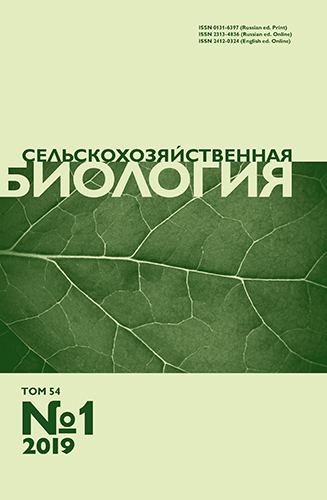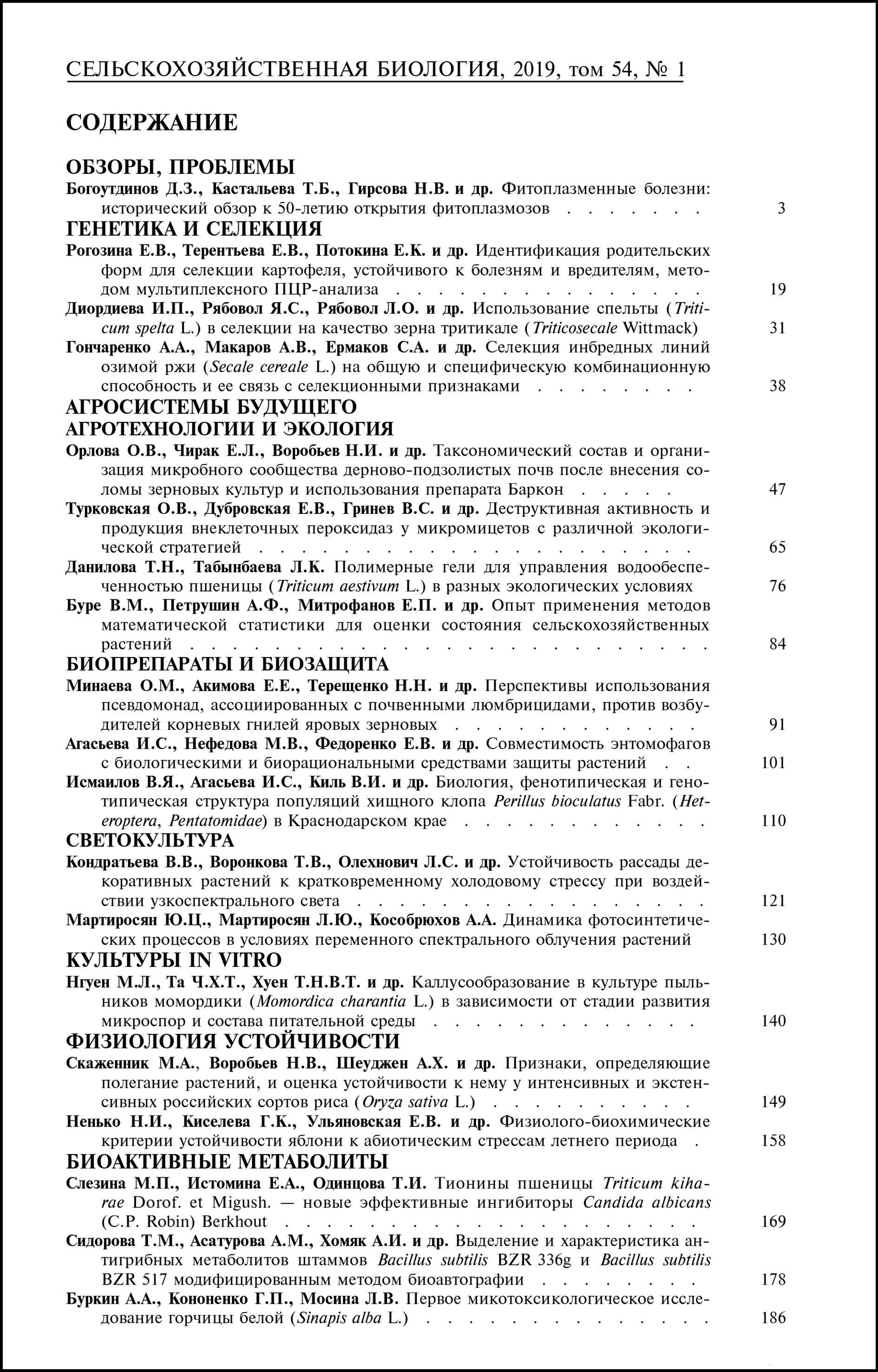doi: 10.15389/agrobiology.2019.1.186rus
УДК 79.64:632.9
ПЕРВОЕ МИКОТОКСИКОЛОГИЧЕСКОЕ ИССЛЕДОВАНИЕ
ГОРЧИЦЫ БЕЛОЙ (Sinapis alba L.)
А.А. БУРКИН1, Г.П. КОНОНЕНКО1, Л.В. МОСИНА2
Сельскохозяйственные культуры, широко представленные как на возделываемых угодьях, так и в естественных ботанических формациях, привлекают все большее внимание исследователей. Это связано с хозяйственной значимостью и высокой ценностью таких растений как экспериментальных объектов. Согласно современным представлениям, комплекс вторичных веществ в растениях рассматривается как совместный продукт их ассоциаций с сообществами микроорганизмов, главным образом микроскопическими грибами (S. Kusari с соавт., 2012). Российскими исследователями выполнен первый цикл работ по сравнительноему изучению содержания микотоксинов в злаковых и бобовых травах на производственных посевах и в естественной среде обитания (G.P. Kononenko с соавт., 2015; A.A. Burkin с соавт., 2017). В представленной работе мы впервые получили сведения о характере контаминации крестоцветных растений токсичными метаболитами микроскопических грибов, выявили различия в их локализации по вегетативным и генеративным органам, а также изменения, сопровождающие полный цикл развития. Целью нашей работы стало изучение состава и содержания токсичных метаболитов микроскопических грибов у горчицы белой (Sinapis alba L.) и оценка распределения этих веществ по органам растения. Объектами анализа были наземные части растений, отобранные в 2017 году с монопосева, а также их листья, стебли, цветки, стручки. Сбор осуществляли в следующие фазы: начало вегетации после завершении формирования базовой структуры растения, массовое цветение, образование зеленых стручков и полное созревание. Методом иммуноферментного анализа определяли содержание Т-2 токсина (Т-2), диацетоксисцирпенола (ДАС), дезоксиниваленола (ДОН), зеараленона (ЗЕН), фумонизинов (ФУМ), альтернариола (АОЛ), афлатоксина В1 (АВ1), стеригматоцистина (СТЕ), роридина А (РОА), циклопиазоновой кислоты (ЦПК), эмодина (ЭМО), охратоксина А (ОА), цитринина (ЦИТ), микофеноловой кислоты (МФК), PR-токсина (PR) и эргоалкалоидов (ЭА). У вегетирующей Sinapis alba в составе комплекса микотоксинов были найдены АОЛ, ЦПК, ЭА, а все остальные метаболиты отсутствовали или выявлялись спорадически. Весьма умеренное накопление микотоксинов в этом растении служит полезным хозяйственным признаком. Среди обследованных ранее злаковых и бобовых трав столь слабо контаминированных культур выявлено не было. В процессе вегетации горчицы состав микотоксинов и количественные соотношения между ними в целом сохранялись, но по мере ее созревания происходило снижение содержания АОЛ и ЦПК. Массовое цветение сопровождалось появлением в растении фузариотоксинов ДАС, ДОН, ФУМ, которые на следующей фазе (формирование стручков) уже не обнаруживались. В экспериментах с отдельными органами Sinapis alba были впервые установлены такие особенности, как множественная и интенсивная контаминация цветков с участием всех анализируемых микотоксинов, полное отсутствие фузариотоксинов в зеленых и спелых стручках, а также повышенное накопление АОЛ в листьях по сравнению со стеблями. Обсуждаются возможные причины этого явления, научная и практическая значимость новых сведений по степени контаминации, сезонной динамике и аккумуляции микотоксинов в этом растении, а также перспективы дальнейшего научного поиска.
Ключевые слова: горчица белая, Sinapis alba, микотоксины, Т-2 токсин, диацетоксисцирпенол, дезоксиниваленол, зеараленон, фумонизины, альтернариол, афлатоксин В1, стеригматоцистин, роридин А, циклопиазоновая кислота, эмодин, охратоксин А, цитринин, микофеноловая кислота, PR-токсин, эргоалкалоиды, иммуноферментный анализ.
THE FIRST MYCOTOXICOLOGICAL INVESTIGATION
OF WHITE MUSTARD (Sinapis alba L.)
A.A. Burkin1, G.P. Kononenko1, L.V. Mosina2
Crops widely represented on cultivated lands and often found in natural botanical formations have attracted increasing attention of researchers in recent years. This is due not only to their economic importance, but also to the high value of both experimental facilities that allow studying the features of the formation of the diversity of biocenotic connections and ecological equilibria. According to modern concepts, a complex of secondary substances in plants is increasingly seen as a joint product of their associations with microorganism communities, mainly microscopic fungi (S. Kusari et al., 2012). Recently, Russian researchers performed the first cycle of studies aimed at a comparative study of the content of mycotoxins in cereals and legumes in industrial crops and in the natural habitat (G.P. Kononenko et al., 2015; A.A. Burkin et al., 2017). In the present work, we obtained first information about the nature of the contamination of cruciferous plants with toxic metabolites of microscopic fungi, revealed for the first time differences in their localization in vegetative and generative organs, as well as changes accompanying the full development cycle. The aim of this work was to study the composition and content of mycotoxins in the white mustard (Sinapis alba L.), a cultivated plant of wide application, which also easily populates agricultural land and occurs in natural grass stands. For analysis, we used overground parts of plants and their organs (leaves, stems, flowers, pods) collected in the white mustard monoculture in 2017 during distinct phases of plant development. These phases were i) the beginning of the growing season after the completed formation of plant basic structure, ii) mass flowering, iii) the formation of green pods and iv) full ripening. The mycotoxins determined by the enzyme-linked immunosorbent assay were T-2 toxin (T-2), diacetoxyscirpenol (DAS), deoxynivalenol (DON), zearalenone (ZEN), fumonisins (FUM), alternariol (AOL), aflatoxin B1 (AB1), sterigmatocystin (STE), roridin A (ROA), cyclopiazonic acid (CPA), emodin (EMO), ochratoxin A (OA), citrinin (CIT), mycophenolic acid (MPA), PR toxin (PR) and ergot alkaloids (EA). AOL, CPA, and EA were found in the mycotoxin complex of Sinapis alba organs during vegetation period, and all other metabolites were absent or detected sporadically. The very moderate accumulation of mycotoxins in this plant is a useful economic property, and previously no such slightly contaminated cultures were detected among examined cereals and legumes. During the vegetation of the mustard, the composition of mycotoxins and the quantitative ratios between them were generally stable, but the content of AOL and CPA decreased as the plant matured. Mass flowering was accompanied by the appearance in the plant of fusariotoxins DAS, DON, FUM, which were not detected in the next phase (pod formation). In experiments with individual organs of Sinapis alba, multiple and intense flower contamination with all analyzed mycotoxins, complete absence of fusariotoxins in green and ripe pods, as well as increased levels of AOL accumulation in leaves compared with stems are established for the first time. Possible causes of this phenomenon, the scientific and practical significance of new information on the degree of contamination, seasonal dynamics and accumulation of mycotoxins in this plant, as well as the prospects for further scientific research are discussed.
Keywords: white mustard, Sinapis alba, mycotoxins, T-2 toxin, diacetoxyscirpenol, deoxynivalenol, zearalenone, fumonisins, alternariol, aflatoxin B1, sterigmatocystin, roridin A, cyclopiazonic acid, emodin, ochratoxin A, citrinin, mycophenolic acid, PR toxin, ergot alkaloids, enzyme immunoassay.
1Всероссийский НИИ ветеринарной санитарии, гигиены и экологии — филиал ФГБНУ ФНЦ ВИЭВ РАН, |
Поступила в редакцию |












